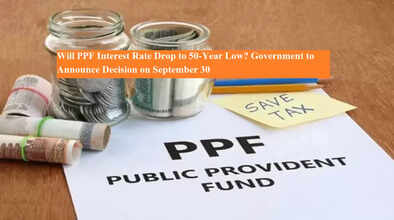Will PPF Interest Rate Drop to 50-Year Low? Government to Announce Decision on September 30

The government is set to review the interest rates of Small Savings Schemes on September 30, 2025, and this time the decision is being closely watched. The biggest focus is on the Public Provident Fund (PPF), which currently offers an interest rate of 7.1%. Market signals suggest that a rate cut is likely, and if that happens, the PPF interest rate could fall to its lowest level in the last 50 years.
Why This Matters
PPF has long been considered one of the safest and most popular savings instruments for Indian households, offering guaranteed returns with tax benefits. Any reduction in its interest rate would directly impact millions of small savers who rely on it for long-term financial security.
The concern is not limited to PPF alone. A cut in rates may also affect other widely used savings schemes such as:
-
National Savings Certificate (NSC)
-
Senior Citizens’ Savings Scheme (SCSS)
-
Sukanya Samriddhi Yojana (SSY)
-
Kisan Vikas Patra (KVP)
-
Post Office Savings Account (POSA)
-
Post Office Monthly Income Scheme (POMIS)
-
Post Office Fixed Deposits (Time Deposits)
These schemes are considered the backbone of India’s small savings ecosystem, especially for senior citizens, middle-class households, and conservative investors seeking secure and guaranteed returns.
Current Scenario: PPF at 7.1%
At present, PPF offers 7.1% annual interest, compounded yearly. This rate has already been among the lowest in decades. If the expected cut materializes, it could reduce returns to a level not seen in half a century. Experts suggest that the rate could potentially fall below 7%, marking a significant turning point for small savings in India.
Why Rates May Be Cut
The possible reduction is linked to falling bond yields and broader macroeconomic conditions. Since the government periodically aligns small savings rates with market interest rates, a decline in government securities’ yields often leads to downward adjustments in schemes like PPF, NSC, and others.
While this helps the government manage borrowing costs, it creates challenges for savers, especially retirees who depend on steady income from these schemes.
Impact on Investors
-
For Senior Citizens: The Senior Citizens’ Savings Scheme (SCSS) and Post Office Monthly Income Scheme (POMIS) are lifelines for retirees. A rate cut would directly reduce their monthly income and affect financial stability.
-
For Families: Schemes like Sukanya Samriddhi Yojana (SSY) are meant for long-term goals such as a girl child’s education and marriage. Lower returns would mean families need to invest more to meet future expenses.
-
For Middle-Class Households: PPF and NSC have been go-to options for safe and tax-efficient savings. A dip in interest rates could push more households towards market-linked instruments, which come with higher risks.
What to Expect on September 30
Investors are anxiously waiting for the government’s decision. If rates are slashed, it will mark a historic low for PPF and impact a wide spectrum of savings products. Experts advise investors to plan ahead and diversify their portfolios to balance the risk of declining guaranteed returns.
Bottom Line
The upcoming announcement on September 30 is not just routine — it could reshape the way millions of Indians approach savings. A 50-year low in PPF interest rates would be a major financial shock, especially for those who depend heavily on fixed-return instruments.
For now, all eyes are on the government’s decision. Whether the rates remain stable or dip further, the outcome will set the tone for small savings investments in the months to come.

